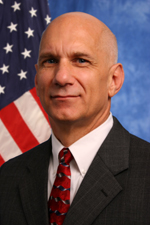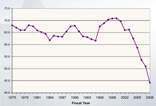
He livened up the discussion in extolling that “We [the Patent Office] don’t have a standard so we’d allow every application if it meets the requirements. Your [Applicants and Attorneys] job is to get all that the applicant is entitled to.”
This is certainly true. The patent statutes state that “A person shall be entitled to a patent unless” the patent statutes preclude the grant (35 USC 102). However, the Commissioner’s statements didn’t sit too well given that these came immediately after he described the plummeting allowance rate at the Patent Office.
In describing the Patent Offices Strategic Plan, Commissioner Doll explained the the two major points are to: (1) improve the quality of examination, and (2) improve the efficiency of system. This is to be accomplished through the four basic principals of quality, timeliness, cost and effect.
In describing Quality, the Commissioner explained that in order to enhance patent quality, the USPTO implemented an improved Quality Assurance Program. One important component of the improved program is expanding the quality review of work products, through a “second-pair-of-eyes” program in areas of identified need. The Office of Patent Quality Assurance (OPQA) administers a program for reviewing the quality of the examination of patent applications. The general purpose of the program is to improve patent quality and increase the likelihood of patents being found to be valid.
The Quality Assurance Specialists re-examine a randomly selected sample of allowed applications to determine whether any claims may be unpatentable. Reviewed applications may be returned to the examining TCs for consideration of the reviewer’s question(s) as to adequacy of the search and/or patentability of a claim(s).
The Commissioner pointed out that the review is not just to find allowances of patents that should not be allowed but to look for rejections that shouldn’t have been made. He did not present any statistics for how many of the latter type of error occurred.
However, in a session entitled “Constructive Ideas on Managing USPTO’s Workload,” the Commissioner showed that in 2008, the USPTO found a 3.7% allowance error rate, which is historically relatively low. The target error rate for the USPTO is 4%. So, technically, they’re under goal but they get to decide the target and they decide what constitutes an “error” or not. With no independent review, is it any surprise that they hit their goal?
In the biotechnology examination group (TC 1600), the allowance error rate is higher at 4.2%. Generally, the <quote> error <unquote> is that the Examiner gave the claims too narrow of an interpretation thereby allowing a claim that should have been rejected in light of the overlap with the prior art.

It is noteworthy that the Commissioner revealed that the number of original applications has remained rather constant. The explosion in filed application numbers (441,637 applications in FY2007) comes from Request for Continued Examination (RCE) filings. With RCE filings are up up 80% in FY2008, it’s no surprise that the backlog in filings is now over 800,000 applications.
This, despite the fact that — as we can see from the steep slope of the graph — we clearly haven’t hit the bottom of the allowance rate decrease. Just how low will the allowance rate have to go before there is an uprising among applicants?

[…] In the ten weeks between the election and the inauguration, we will have plenty of time to ponder what changes, if any, might be in store for the U.S. Patent and Trademark Office. Many believe its interminable quest to improve so-called patent quality has led to a precipitous drop in patent allowances. […]
In accord with traditional USPTO statistical methods, I conclude, based on the last 5 years data, the allowance rate will be ZERO sometime in 2019. (At which point, the USPTO will claim 100% quality.)